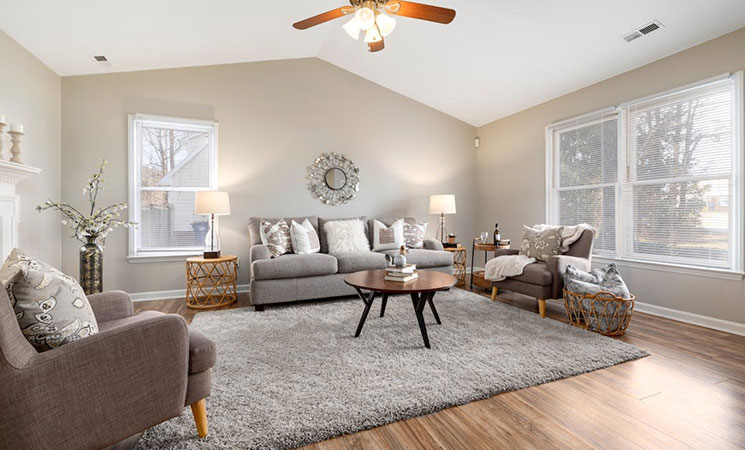Moving into a new home is an exciting experience, but it also comes with the challenge of creating a cohesive and unified design throughout the space. Whether you’re starting fresh in a brand-new build or making an older home your own, the goal is often to harmonize the various rooms and areas to reflect a consistent style. This task can be particularly important for those moving from one city to another, as they may want to either replicate the familiar feel of their previous home or try something entirely different.
For example, if you’re relocating from Miami, you might find yourself torn between maintaining the bright, airy aesthetic common in Miami homes or opting for a new style that suits your new surroundings. Miami homes often feature a mix of modern design with a tropical flair, characterized by light colors, open spaces, and a connection to the outdoors. Moving to a different city might inspire you to either keep some of these elements for comfort or explore a new aesthetic that reflects your new environment. Whatever your choice, achieving a unified home design requires careful planning and strategic decisions.
1. Strategic Placement
One of the first steps in harmonizing your new home’s style is the strategic placement of furniture and other items. The way items are positioned within a space can greatly affect how cohesive the overall design feels. Proper placement can create a natural flow between rooms, which makes the home feel more connected and thoughtfully designed. On the other hand, poorly placed furniture or decor can disrupt the harmony of a space, causing certain areas to feel disjointed or out of place.
Hiring a moving company in Miami can be incredibly beneficial in this process. Professional movers not only help with the heavy lifting but can also assist in positioning your furniture and other items in a way that supports the overall design of your new home. Their experience in arranging spaces can prevent common mistakes, such as overcrowding a room or placing items in a way that blocks natural pathways. This strategic placement is crucial in creating a home that feels cohesive and well-organized from the start.
2. Creating a Consistent Color Palette
Another important aspect of harmonizing your home’s style is the creation of a consistent color palette. When selecting a color scheme, think about how each room will relate to the others. However, this doesn’t mean every room needs to be painted the same color; rather, the colors should complement each other.
Start by choosing a base color that you love, and that can be used throughout the home. This could be a neutral shade like beige, gray, or white, which provides a versatile backdrop for other colors and styles. Once you have your base, you can add complementary accent colors in different rooms to create interest and variation without losing the sense of unity. For example, a soft gray could be paired with muted blues and greens in one room, while another space might feature warm tones like beige with touches of gold or rust.
3. Coordinating Styles Across Rooms
The furniture and decor you choose play a significant role in creating a cohesive style throughout your home. Mixing different styles can add character and depth to your home, but it should be done thoughtfully to avoid a disjointed appearance. For example, if your living room has a modern feel with clean lines and minimalistic furniture, carrying that theme into other areas of the home can help maintain a consistent style.
However, this doesn’t mean every room needs to look identical. You can still incorporate different styles as long as there’s a common thread that ties them together. For instance, you might combine traditional and contemporary elements by using similar colors, materials, or shapes that echo each other across different spaces. This approach allows for a variety of styles while still achieving a cohesive and harmonious design.
4. Incorporating Textures and Materials
The choice of materials can significantly influence the overall feel of a space, contributing to its warmth, modernity, or elegance. When different textures and materials are used thoughtfully, they can add depth and interest to a room while maintaining a sense of unity. For example, a combination of wood, metal, and fabric can be used across different spaces to tie them together, provided these materials complement each other and follow a consistent theme.
Incorporating similar materials in various rooms creates a visual link that elevates the overall design. For instance, if you choose to use natural wood in your living room, consider carrying that element into the kitchen with wooden countertops or cabinetry. Similarly, if you have metal accents in one area, such as in light fixtures or furniture legs, repeating those accents in other parts of the home can create a cohesive look.
5. Thoughtful Use of Decor and Accessories
When chosen carefully, these elements can emphasize the style and theme you’ve established throughout your home. For example, using similar styles of artwork, throw pillows, or vases across different rooms can help attain a consistent look. Nonetheless, consider how each piece of decor fits within the larger context of your home’s design. A chic square storage ottoman can serve as both a functional piece and a stylish accessory, seamlessly blending into your home’s design.
To maintain harmony, focus on decor that complements your chosen color palette, textures, and materials. If you have opted for a modern, minimalist aesthetic, choose accessories that adhere to this style, such as sleek, understated items in neutral tones. Alternatively, if your home has a more traditional or eclectic vibe, you can mix different types of décor. However, aim for a common thread—like a recurring color or pattern—that ties everything together.
6. Consistent Lighting Choices
Lighting is another key factor in harmonizing your home’s style. The right lighting can highlight the design elements of a room and contribute to a unified look throughout the house. Consistency in lighting fixtures and styles helps maintain the aesthetic flow from one room to another. For example, if you have modern, sleek lighting in the kitchen, using similar styles in adjacent areas like the dining room or living room can create a seamless transition between spaces.
However, consistency doesn’t mean uniformity. While it’s important to keep the overall style coherent, different rooms may require different types of lighting based on their function. For instance, task lighting is essential in the kitchen, while ambient lighting might be more appropriate for a living room or bedroom. Even with these differences, choosing fixtures that share common design elements—such as matching finishes or complementary shapes—ensures that the lighting across your home feels cohesive.
Bringing together all the elements of your new home’s style requires careful planning and thoughtful execution. From the strategic placement of furniture to the selection of consistent colors, materials, lighting, and decor, each decision plays a crucial role in achieving a harmonious design. Ultimately, a well-harmonized home is one where every room contributes to a cohesive and inviting atmosphere.














